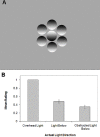The perception of shape from shading in a new light
- PMID: 24795853
- PMCID: PMC4006223
- DOI: 10.7717/peerj.363
The perception of shape from shading in a new light
Abstract
How do humans see three-dimensional shape based on two-dimensional shading? Much research has assumed that a 'light from above' bias solves the ambiguity of shape from shading. Counter to the 'light from above' bias, studies of Bayesian priors have found that such a bias can be swayed by other light cues. Despite the persuasive power of the Bayesian models, many new studies and books cite the original 'light from above' findings. Here I present a version of the Bayesian result that can be experienced. The perception of shape-from-shading was found here to be influenced by an external light source, even when the light was obstructed and did not directly illuminate a two-dimensional stimulus. The results imply that this effect is robust and not low-level in nature. The perception of shape from shading is not necessarily based on a hard-wired internal representation of lighting direction, but rather assesses the direction of lighting in the scene adaptively. Here, for the first time, is an experiential opportunity to see what the Bayesian models have supported all along.
Keywords: 3D shape perception; Illusion; Shape from shading; Vision; Visual perception.
Figures

Similar articles
-
3D shape-from-shading relies on a light source prior that does not change with age.Vision Res. 2020 Dec;177:88-96. doi: 10.1016/j.visres.2020.09.002. Epub 2020 Sep 28. Vision Res. 2020. PMID: 33002649
-
Directional Bias in the Perception of Cast Shadows.Iperception. 2017 Jan 1;8(1):2041669516682267. doi: 10.1177/2041669516682267. eCollection 2017 Jan-Feb. Iperception. 2017. PMID: 28210485 Free PMC article.
-
On the perception of shape from shading.Percept Psychophys. 1992 Jul;52(1):18-36. doi: 10.3758/bf03206757. Percept Psychophys. 1992. PMID: 1635855
-
Perceiving light versus material.Vision Res. 2008 Sep;48(20):2090-105. doi: 10.1016/j.visres.2008.03.020. Epub 2008 May 13. Vision Res. 2008. PMID: 18479723 Review.
-
Perceiving the shape and material properties of 3D surfaces.Trends Cogn Sci. 2023 Jan;27(1):98-110. doi: 10.1016/j.tics.2022.10.005. Epub 2022 Nov 10. Trends Cogn Sci. 2023. PMID: 36372694 Review.
Cited by
-
Anticlockwise or clockwise? A dynamic Perception-Action-Laterality model for directionality bias in visuospatial functioning.Neurosci Biobehav Rev. 2016 Sep;68:669-693. doi: 10.1016/j.neubiorev.2016.06.032. Epub 2016 Jun 24. Neurosci Biobehav Rev. 2016. PMID: 27350096 Free PMC article. Review.
-
Reference Frames and 3-D Shape Perception of Pictured Objects: On Verticality and Viewpoint-From-Above.Iperception. 2016 Jun 29;7(3):2041669516637286. doi: 10.1177/2041669516637286. eCollection 2016 May. Iperception. 2016. PMID: 27433329 Free PMC article.
References
LinkOut - more resources
Full Text Sources
Other Literature Sources

